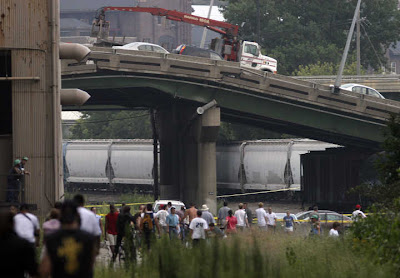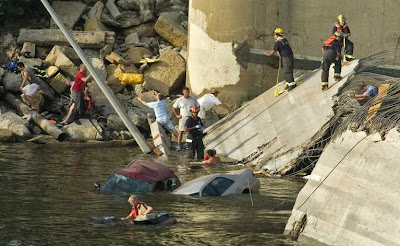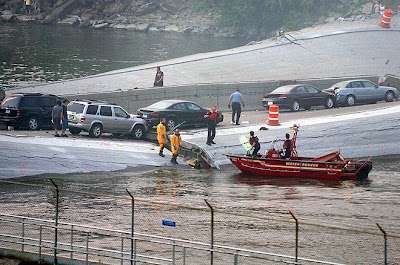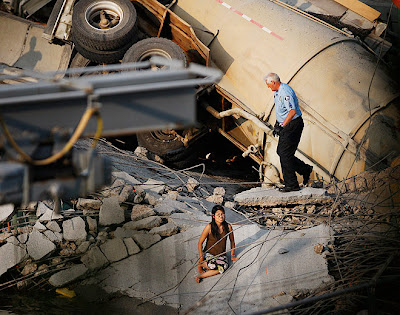Minnesota Bridge Collapse Kills
































Aug. 2 (Bloomberg) -- The 40-year-old Minneapolis bridge that collapsed yesterday was being repaired when it buckled and dropped into the Mississippi River, killing four people and leaving at least 20 missing, officials said.
``A bridge in America shouldn't just fall down,'' U.S. Senator Amy Klobuchar, a Minnesota Democrat, said in a local news conference. ``We have to get to the bottom of this.''
Divers expect to find more bodies and are focusing on recovery rather than rescue, Minneapolis Fire Chief James Clack said.
The National Transportation Safety Board, which will investigate, declined to describe the repairs that were being made yesterday. The governor said several projects were under way, including concrete replacement, guardrail and lighting repairs and work on the joints.
Two years ago, the Interstate 35W bridge scored 50 out of 120 in a federal highway inspection, indicating it was ``structurally deficient.'' The rating means replacement is needed eventually, not that a bridge is unsafe, U.S. Transportation Secretary Mary Peters said at the conference.
As many as 80,000 bridges in the U.S. share the rating, said Governor Tim Pawlenty. ``There was no call by anyone that it should be closed,'' he said. However, he ordered an immediate inspection of all similarly designed bridges in the state.
The six-story span buckled during the bumper-to-bumper traffic in the early evening rush hour, tossing as many as 50 vehicles into the river, officials said. The Associated Press, citing hospital officials, said at least 79 people were injured.
Three Sections Collapse
The eight-lane bridge near the University of Minnesota and the Metrodome stadium, where the Minnesota Twins baseball team was playing, stretched almost 2,000 feet (610 meters). Three of its four sections gave way, collapsing into the water and onto a freight train running on riverside tracks.
``It apparently is just a loading and unloading track,'' said Tom White, a spokesman for the Washington-based Association of American Railroads. ``It's not a real busy line.''
U.S. grain and freight shipments on the river are unlikely to be disrupted by the collapse because most cargo is loaded downstream, traders and a U.S. Coast Guard spokesman said.
The bridge, built in 1967, was inspected in 2005 and 2006. A March 2001 study by the state's transport agency found that the approach spans ``exhibited several fatigue problems, primarily due to unanticipated out-of-plane distortion of the girders. Concern about fatigue cracking in the deck truss is heightened by a lack of redundancy in the main truss system.''
The agency recommended that the deck be replaced by 2020 or beyond, Pawlenty said.
Bridge Just `Vanished'
South Minneapolis resident Xavier Sose said he was standing in the doorway of his balcony yesterday when he heard and felt a low rumble. He looked toward the bridge and saw dust shoot out of each end.
``The next thing you know, the entire center section of the bridge just vanished,'' he said in a phone interview. ``Cars were sliding down, and everything was covered in dust.''
Survivors were taken to the riverbank and transported to area hospitals, Minnesota State Patrol spokesman Steve Johnson said.
A school bus carrying about 60 children was on the bridge. As many as 10 were taken to hospitals and the rest released to their families, Ted Canova of the American Red Cross said. He put out a call for blood donors and financial donations.
The Hennepin County Medical Center received one drowning victim, six others with serious injuries and 22 more with non- critical injuries, Joseph Clinton, chief of emergency medicine, said in a televised news conference.
``We in the federal government must respond, and respond robustly, to help the people there not only recover, but to make sure that lifeline of activity -- that bridge -- gets rebuilt as quickly as possible,'' President George W. Bush told reporters this morning.
Photos: © AP/Scanpix
© Jeff Willer, Tom Sweeney, Joey McLeister,
David Brewster, Brian Peterson / Star Tribune
To contact the reporter on this story:
James Temple in San Francisco at jtemple@bloomberg.net ;
Demian McLean in Washington at dmclean8@bloomberg.net .
© Jeff Willer, Tom Sweeney, Joey McLeister,
David Brewster, Brian Peterson / Star Tribune
To contact the reporter on this story:
James Temple in San Francisco at jtemple@bloomberg.net ;
Demian McLean in Washington at dmclean8@bloomberg.net .

